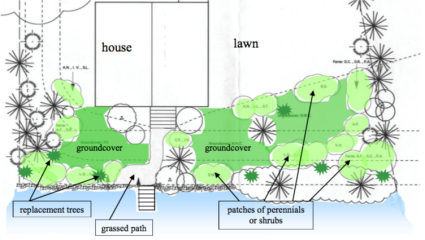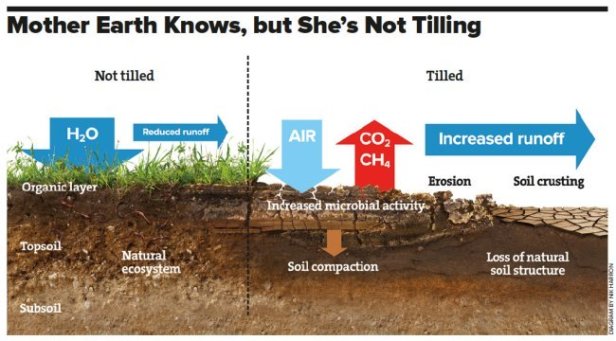As a collective whole, we humans are making dangerous adjustments to our planet’s thermostat. Then again, as individuals, many of us are searching for ways to reverse this trend. For now, look no farther than the patch of ground beneath your feet.
You may be standing on the second story of an office building or on a parking lot, but beneath these trappings, lies potential. As opposed to just a blank slate in which we grow our veggies, healthy soil is a living entity and a crucial carbon sink.
Plants convert CO2 into chemical energy through photosynthesis. Rather than being released back to the atmosphere, this carbon can end up in the soil thanks to the host of microbes that do business with plant roots. Essentially, living plants leak extra carbon to bacteria and fungi in the soil in exchange for other nutrients. Soil organisms use this energy to go about their lives, and in the process, they transform decaying organic matter into humus.
 Despite lacking a second “m,” humus does relate to the delicious Mediterranean spread in the sense that it is extremely important to soil fertility, and thus all plants, garbanzo beans notwithstanding. Although humus is highly complex and difficult to define, there is no mystery shrouding its relative stability. Humified carbon can stick around for well over a hundred years in the soil without degrading to CO2. 1 So, we can picture high-functioning soil as a massive carbon sponge capable of storing thousands of gigatonnes of carbon.2
Despite lacking a second “m,” humus does relate to the delicious Mediterranean spread in the sense that it is extremely important to soil fertility, and thus all plants, garbanzo beans notwithstanding. Although humus is highly complex and difficult to define, there is no mystery shrouding its relative stability. Humified carbon can stick around for well over a hundred years in the soil without degrading to CO2. 1 So, we can picture high-functioning soil as a massive carbon sponge capable of storing thousands of gigatonnes of carbon.2
But, what about soil that no longer hosts an ecosystem of humus-makers? Unfortunately, there’s a lot of it underfoot. Any number of crops may soon be planted in such soils across the continent this summer. Widespread application of chemicals has largely uncoupled conventional agriculture from soil health in the modern era. In excess, fertilizers, herbicides, pesticides, and fungicides can severely alter microbial communities, rendering the soil inherently less fertile (so it requires even more inputs), and ultimately reducing its carbon-storing capacity.3

But, let’s set industrial agriculture aside, and ground this conversation closer to home. At the very least, we can all be the land managers of our own backyards. Even damaged dirt can recover if we are willing to get our hands dirty restoring soil health. As you roll up your sleeves, keep the following principles in mind:
1. Less Lawn
Let’s face it, despite being costly
to maintain in terms of cash, water, and fossil fuel, many of us still want tidy, green grass in our lives. Nevertheless, we can shrink our lawns and our carbon footprint in step. Even if you replace just the corners of your lawns with native shrubs and cover plants, you can improve soil health and streamline your lawnmower’s trajectory. Ask around at your local plant nursery to select suitable, native vegetation that’s pleasing to the eye and to the soil microbes.
2. More Mulch
Don’t toss the grass clippings when you trim your now-svelte lawn. Use them as a “green manure” to boost the health of your yard. Let them dry for a few days, and then incorporate them as needed around flowerbeds, trees, or shrubs. Also, use mulches such as straw, leaves, or wood chips on top of your soil as a protective blanket to encourage soil moisture and to reduce weeds.
3. You till, you kill
Admittedly, this mantra is a bit of an overstatement. Tilling can be very useful; experienced gardeners routinely dig up tidy rows in the spring. But, tearing up the dirt disturbs the living soil community and the resources they depend on. Avoiding tillage can improve soil moisture, prevent soil loss, and promote soil fertility in the long run.
4. Don’t dare to bare
Perhaps the most important lesson of all is to minimize bare soil. Carbon stored in soil can rapidly escape to the atmosphere as CO2 when exposed to the air. Prevent this scenario by keeping pathways narrow, tilling less, and covering exposed soil with vegetation or mulch.
Additional Resources:
- Eight Steps for Making Better Garden Soil
- Lawn Alternatives
- Plants and Plantings on Lakeshore
- Advantages and Disadvantages of a Tillage System
Sources:
- Dungait, J. A. J., Hopkins, D. W., Gregory, A. S. and Whitmore, A. P. 2012. Soil organic matter turnover is governed by accessibility not recalcitrance. Glob Change Biol, 18: 1781–1796.
- Ecological Society of America. 2000. Carbon sequestration in soils.
- Schwartz, J. 2014. Soil as carbon storehouse: new weapon in climate fight? Yale Environment 360.
- Barker, D. and M. Pollan. 2015. A secret weapon to fight climate change: dirt. The Washington Post.






